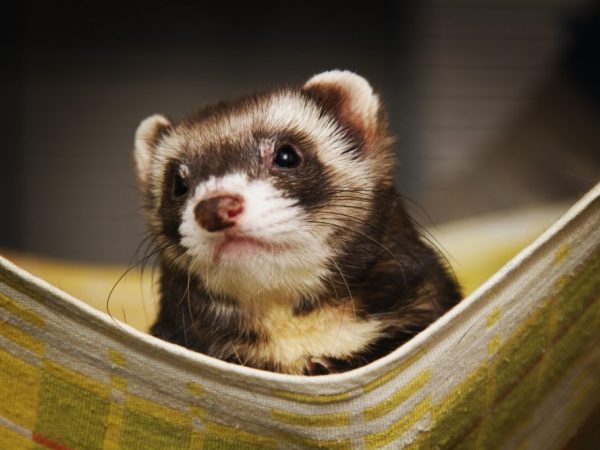Making a hammock for a ferret yourself
A comfortable hammock for your ferret is not a whim or an overkill, but an absolute must. The good thing about the hammock is that it takes the shape of the animal's body, like the soft earth on which the ferret is used to sleeping in natural conditions. Let's take a look at how to make your own ferret hammock using fabric or items at hand.

Ferret hammock
What you need to know
Making a hammock for a ferret with your own hands is not difficult, but first you should decide on the functions of a new bed. In a hammock, a mischievous ferret can not only sleep, but also play, observe the world around him, sit in ambush, and explore the "prey". Depending on the required functionality, you can come up with and sew the appropriate models of hammocks (in the form of a canvas, pipe, bag, house, etc.).
Ferret hammocks can be designed for cold or warm seasons: in summer, the animal will need a hammock made of thin fabric or mesh, in winter - from warm felt, drape, cashmere.
However, remember: the ferret has great agility and sharp claws, so the thin fabric must have a high density, otherwise the animal will quickly deal with the creation of your hands.
To entertain the animal, you can sew pockets or a pipe to the hammock, put rustling materials in the inner layer, and sew in squeaky toys.
From fabric
The simplest pattern is in the shape of a square (30cm) or rectangle (30cm X 45cm). If there are several ferrets, the size of the hammock can be increased, commensurate with the free space inside the cage (the hammock should not interfere with the realization of other needs of the animal). We put two pieces of fabric together and sew on three sides, and then turn the product inside out and sew on the fourth side. If we want to make a lined hammock, put the lining fabric on top of two upholstery pieces and sew it as in the previous case.
If necessary, you can put a soft pillow or toys inside the hammock before sewing the third side. We sew ribbons to the ends of the resulting mattress, with which the hammock will be tied to the rods of the cage. For more convenience, instead of ties, you can use carabiner fasteners. Alternatively, you can make a pocket-like hammock by simply cutting a hole in the center of the top piece of fabric. You will get something like a duvet cover in which the ferret can hide, bask and at the same time look around, sticking his head into the hole.
From felt boots

Hammock made of any material
An excellent hammock for a restless ferret can be built from an ordinary felt boot. Such a product involves a minimum of do-it-yourself work, but it can serve for an animal not only as a bed, but also as a house. In addition, the felt boot is remarkable for its versatility (thanks to the properties of felted wool): a ferret in such a hammock does not freeze in winter and does not suffer from the heat in summer. All you need to do is to sew the ribbons on both sides of the felt boot, turned horizontally (toe up), and hang it in the right place.
Out of the bag
A small ladies' or children's handbag made of natural materials will become a wonderful hammock.The only thing is that before you launch a ferret into it, small parts and accessories must be cut off. Summer openwork hammocks can be crocheted with your own hands or weaved using the macrame technique, and warm winter "cradles" can be knitted. With a little imagination, you can create hammocks for ferrets from the elements of your clothing: hood, sleeves, pant leg, sock, pocket, scarf, etc.
Recommendations
- It is better to have several different ferret hammocks, alternating between them not only as the seasons change, but also as it gets dirty.
- The hammock-canvas can be hung in the cage in different ways: open - tied or fastened to the rods, or rolled up - by collecting all the ribbons together and attaching them to the upper wall of the cage.
- Taking care of the health and well-being of your pets, use only natural fabrics and materials for sewing "beds". (In addition, a ferret in a synthetic hammock can sparkle - some materials make its wool electrified.)
- Do not sew on toys outside that can be chewed and swallowed - if the pieces of synthetic materials are not digested in the stomach, the animal can get sick and even die.
- Unlike the material, the color of the hammock does not really matter to ferrets, since these animals do not distinguish between bright colors.


